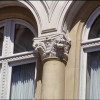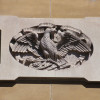Des Moines, Iowa
The Iowa State Capitol was built from 1871 to 1886 in a modified Renaissance style and is crowned by a gold-leaf dome 80 feet in diameter, 275 feet high. Restoration of the Capitol began in 1984 and was ongoing for nearly two decades, with Bybee Stone Company performing all phases of the work of fabricating replacement components for the deteriorating sandstone trim. According to Will Bybee, president of Bybee Stone, it was the company's largest restoration project because of the record amount of ornamental carving work.
The project was done in phases large and small, depending on appropriations made by the Iowa State Legislature, and bid out individually. One phase caused great excitement in Indiana: Bybee Stone’s Job 111, which included the replacement – in limestone – of the massive west portico’s pediment, carved in high relief. The original sandstone was severely eroded and had to be shipped in pieces to Bybee for replication.
Carl Crees, the superintendent for Neuman Brothers, was part of the effort to remove the original carved sandstone pedimental statuary above the west entrance, and in 2001 he talked about his experiences, including his trip to Bybee Stone Company to watch the carving of the replacement figures: Commerce, Justice, Liberty, Knowledge and Agriculture. His interview is archived online with Iowa Public Television’s “This Old Statehouse.”
The part of the project Crees referred to was completed in 1991 and consisted of 21 pieces forming the pedimental statuary – 15 feet in height by 42 feet in length – which had originally been fabricated in sandstone by S. Cottin in 1879. The rough limestone blocks needed to duplicate the pediment had a combined weight of 148,000 pounds. The head carver for Job 111 was Jeff Leisz, now Bybee Stone Mill superintendent. At the time, master carver Leisz reported to the local Herald Times newspaper that, “Nothing like this has been done in a long, long time. We all cherish the opportunity to do work like this, preserving history.”












